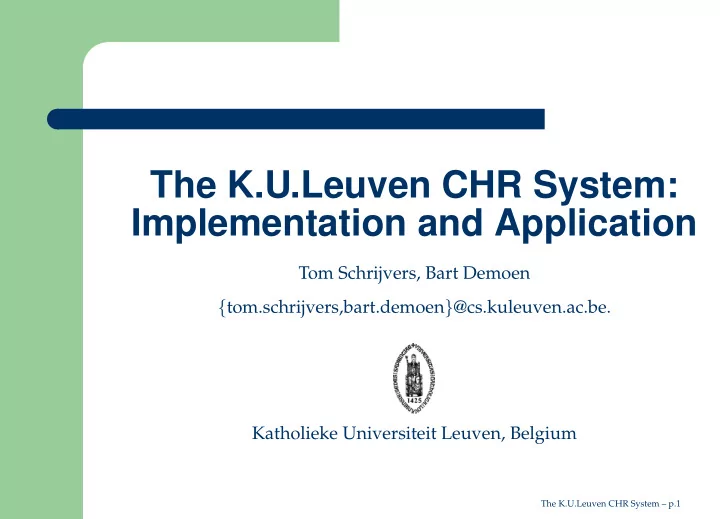

The K.U.Leuven CHR System: Implementation and Application Tom Schrijvers, Bart Demoen { tom.schrijvers,bart.demoen } @cs.kuleuven.ac.be. Katholieke Universiteit Leuven, Belgium The K.U.Leuven CHR System – p.1
Overview of the Talk � 1. Implementation � 1.1 Setup and Evolution � 1.2 Optimizations � 1.3 Evaluation � 2. Application � 2.1 Well-Founded Semantics � 2.2 Java Memory Model � 3. Conclusion � 3.1 Future Work � 3.2 Discussion Topics The K.U.Leuven CHR System – p.2
1. Implementation The K.U.Leuven CHR System – p.3
1.1 Setup and Evolution K.U.Leuven CHR system consists of two parts: � the runtime � strongly based on Christian Holzbaur’s � finetuned for performance � the preprocessing compiler � CHR = ⇒ Prolog The K.U.Leuven CHR System – p.4
1.1 Setup and Evolution � hProlog (Bart Demoen) � evaluate new attributed variables � optimized compilation of CHRs � XSB (David S. Warren) � along with hProlog’s attributed variables � integration of CHR with tabling (ICLP’04) � SWI-Prolog (Jan Wielemaker) � along with hProlog’s attributed variables � first CLP capabilities in SWI-Prolog The K.U.Leuven CHR System – p.5
1.2 Optimizations Based on other systems and own ideas: � heuristic reordering of constraints in multi-headed rules � early scheduling of guards � detection of never attached constraints ⇒ other constraints in same rule passive = ⇒ avoid space and time overhead = The K.U.Leuven CHR System – p.6
1.2 Optimizations � functional dependencies inference ⇒ once transformation = a(X,_) \ a(X,_) <=> true. b(X), ..., a(X,Y), ... ==> ... procedure_b(X) :- ... % retrieve other constraints once ( retrieve_a(X,Constraint) ), ... % retrieve other constraints !, ... The K.U.Leuven CHR System – p.7
1.2 Optimizations � inference of unmatched arguments ⇒ no attaching = entry(Key, Value ) \ lookup(Key,Query) <=> Query = Value. ?- entry(123,[Var1,Var2,...,Var10]), lookup(123,Query). entry/2 is redundantly (de/at)tached The K.U.Leuven CHR System – p.8
1.2 Optimizations � inference of unmatched arguments conditions for argument in all rules: � argument is a variable � variable only appears once in heads and guard � variable may appear in (anti-monotonic) var test: fib(N,M1) \ fib(N,M2) <=> var(M2) | M1 = M2. fib(N,M) ==> N =< 1 | M = 1. fib(N,M) ==> N > 1 | N1 is N-1, fib(N1,M1), N2 is N-2, fib(N2,M2), M is M1 + M2. The K.U.Leuven CHR System – p.9
1.3 Evaluation Factors: � Plain Prolog performance SICStus Yap hProlog XSB SWI-Prolog average 100.0% 78.0% 76.2% 146.8% 448.2% � CHR optimizations + instantiation errors (disabled) � Attributed variables implementation � global store is hotspot � short reference chains The K.U.Leuven CHR System – p.10
1.3 Evaluation Christian Holzbaur K.U.Leuven Benchmark SICStus Yap hProlog XSB SWI-Prolog bool 100.0% 74.1% 43.3% 86.0% 207.0% fib 100.0% 61.7% 76.5% 154.9% 538.9% fibonacci 100.0% 59.6% 35.4% 82.2% 270.0% leq 100.0% 96.0% 81.6% 151.1% 454.4% primes 100.0% 104.8% 51.3% 139.5% 520.3% ta 100.0% 82.6% 53.1% 106.2% 380.4% wfs 100.0% 63.6% 52.5% 125.9% 309.3% zebra 100.0% 52.6% 21.3% 50.8% 139.1% average 100.0% 74.4% 51.9% 112.1% 352.4% The K.U.Leuven CHR System – p.11
2. Application The K.U.Leuven CHR System – p.12
2.1 Well-Founded Semantics Algorithm to compute WFS of logic programs without arguments. Fixpoint of 2 steps: � step 1 � decide truth of atoms based on facts and already defined atoms � step2 � only consider undefined atoms and positive body literals � apply same reasoning as in step 1 � still undefined: false are considered false � now defined: remain undefined The K.U.Leuven CHR System – p.13
2.1 Well-Founded Semantics Prototype implementation in CHR � sequencing of steps: flag constraints to enable/disable rules � stop fixpoint: dirty flag constraint + order of rules � different semantics step 1 vs. step 2: replace c1/n with c2/n � available as wfs.chr Refined operational semantics crucial! The K.U.Leuven CHR System – p.14
2.1 Well-Founded Semantics Some used CHR idioms/patterns/hacks: witness2 \ witness2 <=> true. phase2, nbucl(At,_) ==> witness2, undefined2(At). phase2, pos(At,Cl) ==> pos2(At,Cl). phase2, aclause(Cl,At) ==> aclause2(Cl,At). phase2, nbplit(Cl,N) ==> nbplit2(Cl,N). phase2, witness2 # ID <=> phase1 pragma passive(ID). phase2 \ nbplit2(_,_) # ID <=> true pragma passive(ID). phase2 \ aclause2(_,_) # ID <=> true pragma passive(ID). phase2 <=> true. The K.U.Leuven CHR System – p.15
2.2 Java Memory Model Java Memory Model flawed � memory model: interaction threads - main memory � JSR-133: new memory model � Concurrent Constraint-based Memory Machines (V. Saraswat): � framework for memory models � events + constraints � rules for ordering between events � rules for linking reads to writes The K.U.Leuven CHR System – p.16
2.2 Java Memory Model CHR implementation � prove claim of CCMMs: generative models � CHR used for � finite domain constraints � partial order � ordering and linking rules � poster at ICLP’04 The K.U.Leuven CHR System – p.17
3. Conclusion The K.U.Leuven CHR System – p.18
3. Conclusion � fairly portable CHR system � hProlog � XSB � SWI-Prolog � competitive performance � tabling in XSB The K.U.Leuven CHR System – p.19
3.1 Future Work � Debugger (Jan Wielemaker) � Optimizations � Instantiation and other declarations � Intelligent backtracking (+ backmarking)? � CHR without global store? � Tabling specific features and applications in XSB The K.U.Leuven CHR System – p.20
3.1 Discussion Topics � One CHR Standard � Syntax � Semantics � Portable Options and Pragmas � Programming in the large? � Benchmark Suite The K.U.Leuven CHR System – p.21
Recommend
More recommend